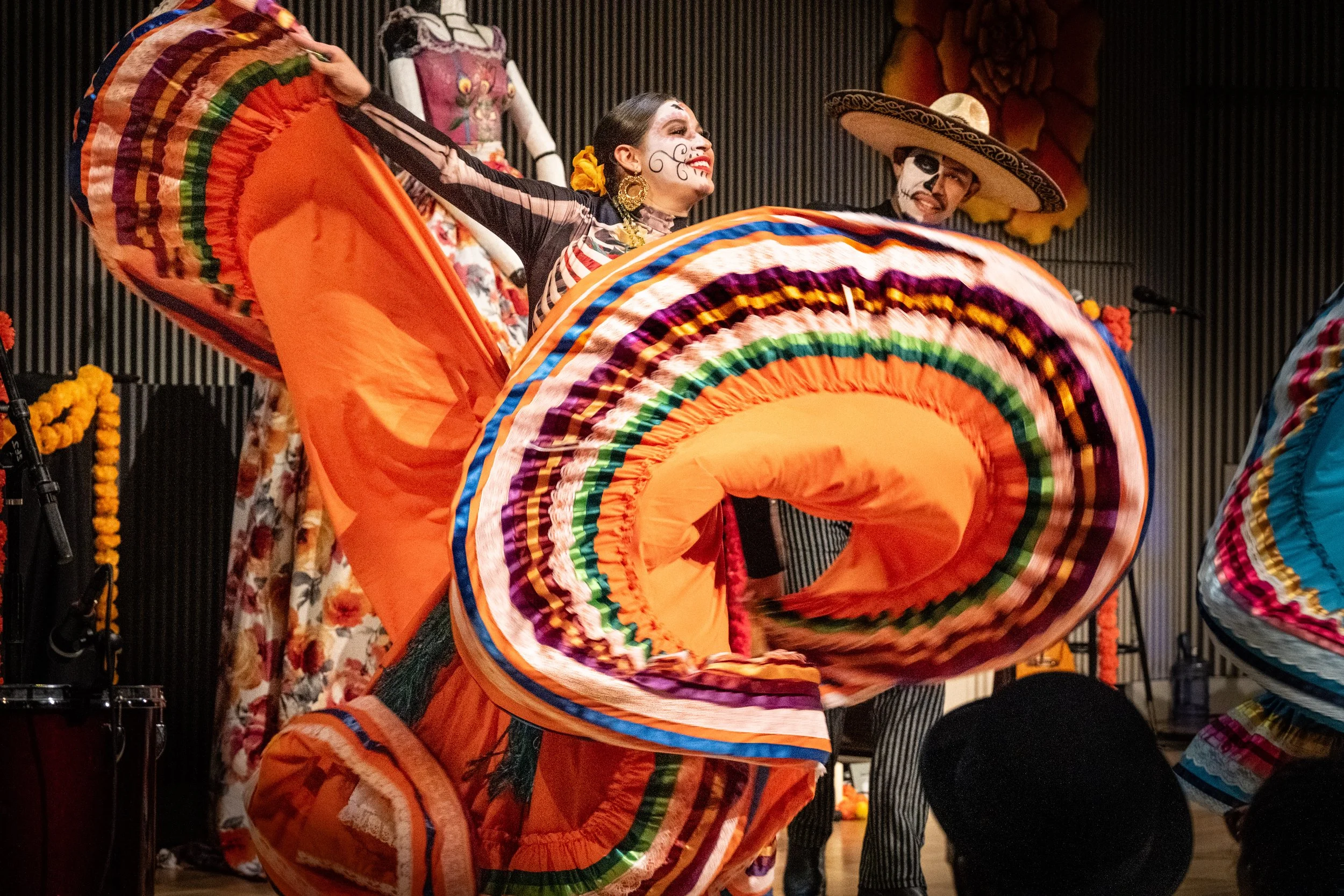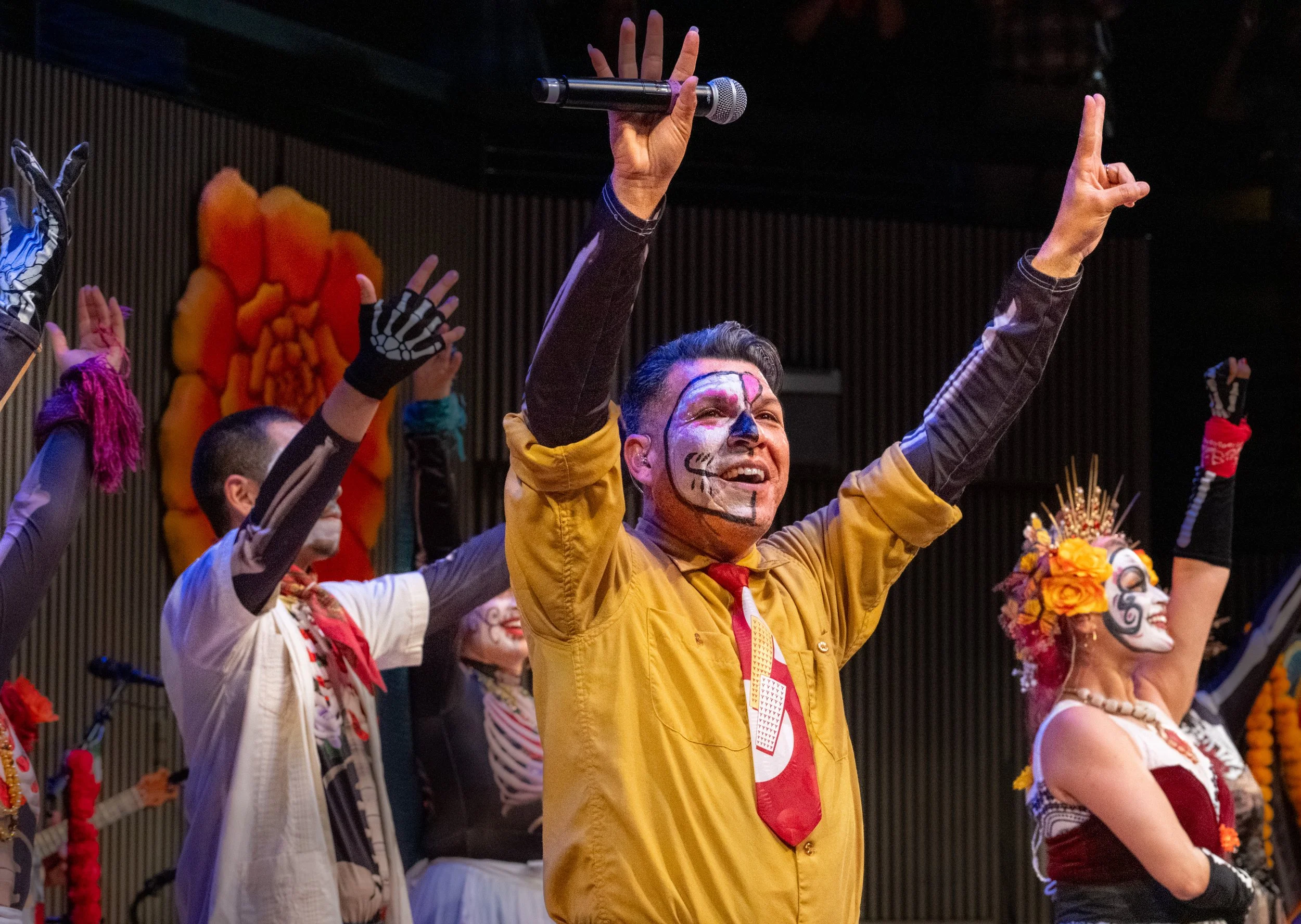Las Cafeteras Offer Evening Of Spiritual Storytelling
A Día de los Muertos ritual of music, dance, and testimony transformed Miner Auditorium into a living ofrenda.
Miner Auditorium resembled a communal altar on Halloween, with flickering candles, portraits of ancestors glowing, and a towering Día de los Muertos figure watching over. The stage was set as an ofrenda—the Día de los Muertos altar, filled with portraits and marigolds—while Hasta La Muerte unfolded as a ceremony of sound, dance, and testimony. The staging encouraged families to share their memories with the public, and the music provided a structure for those memories. From the first image to the last chorus, the night celebrated remembrance in life and involved the audience as participants and relatives.
Hasta La Muerte’s Backstory
Bandleader Héctor Flores first sketched Hasta La Muerte in 2017 after seeing the Disney film Coco. He went home and wrote through the night, shaping scenes that honored elders, neighborhood stories, and the everyday language of grief and joy. Hasta La Muerte evolved from a song into a full production that embodies the texture of a community gathering: photographs on an ofrenda, food memories shared from the stage, and a crowd invited to sing, clap, and wave their arms.
The piece now tours the U.S. as a bilingual ritual with a straightforward narrative and space for local details. At Miner, that meant costume accents across the hall and voices responding to the band in Spanish and English. The backstory matters because it influences the show’s tone: less museum display, more living performance supported by theater craft.
Photo: Steve Roby
Introduction of La Catrina
Act I opened with José Guadalupe Posada’s stark reminder—“Death is democratic”—and a graceful entrance by La Catrina (Adriana Rafaela), who guided travelers between worlds with calm authority. The scene established a language of gesture and sound: the gentle tilt of her head, the shimmer of jarana strums, and the bright replies of the requinto. La Llorona entered as a mother held in grief, and La Santa de los Muertos welcomed her home. The orchestration blended Oaxacan brass tones with modern rhythm programming, honoring lineage while speaking in current vernacular.
This introduction also set the tone for the evening’s message of gratitude. Instead of fear, the show chose welcome; instead of a sermon, it opted for a story. That clarity helped each character feel human scale, even when rooted in myth.
Flores stepped out of character to share a family story that redefined the word “bruja.” The story was straightforward: a neighbor who arrived with healing practices during a time of need, described with warmth and respect. The transition from childhood fear to adult understanding connected the folklore with real-life experience, setting the stage for the evening’s main theme—ritual as a social art formed through testimony.
Musically, the band supported the monologue with a restrained groove. A low bass line kept time while subtle percussion followed the speaker’s rhythm, and the audience leaned forward, listening for detail. That focus created the concert’s most valuable resource: silence that held meaning.
Photo: Steve Roby
La Bruja — The Healer
The vignette grew into a choreographed circle. Dancers moved with kitchen-table intimacy, passing a small object hand to hand as if sharing home remedies; the lighting shifted from cool blues to warm ambers. The music brightened from a minor tone to a more uplifting sound, and the jarana’s forward strum gave the tarima a steady heartbeat. What might seem like myth on paper felt like fond neighborhood wisdom delivered with rhythm and grace.
A humorous recollection of a talkative partygoer at an annual event kept the atmosphere light, and the band shifted smoothly from a drum kit to a cajón. The sequence showcased the company’s balance, a ceremony that blended humor, reverence, and an invitation to dance.
Denise Carlos. Photo: Steve Roby
Challenges of Migration and Community Support
The frame expanded to migration. Dancers with monarch butterfly wings swept across the stage—an image of endurance—while projections displayed border news: desert crossings, makeshift graves marked by white pipe crosses, and faces now held in memory. Flores spoke of courage and the protective labor of women, and the song that followed carried their names with a steady, dignified pulse.
Rhythm did the heavy lifting here. Tarima patterns conversed with the drum set, and the bass maintained a grounded two-bar cycle that allowed the text to breathe. Audience attention sharpened; people listened with stillness, then exhaled together as the final chord rang.
A child’s voice envisioned an afterlife where endless pan dulce and simple joys persist. Glockenspiel tones added sparkle, and close harmonies wrapped the melody like a locally woven blanket. The lullaby “Sing Me To Sleep” ended Act I with peaceful acceptance, and the silence that followed felt like part of the music.
Act II
Héctor Flores. Photo: Steve Roby
La Catrina reappeared in a lighter mood, welcoming the audience to the afterlife and reminding us that the road between worlds takes courage. Flores offered a drummer’s benediction—follow the beat through fire, monsters, and even ICE—and the band responded with a strong downbeat. Then came the bridge between ritual and rock-and-roll history: a tribute to Richard Steven Valenzuela (Richie Valens), a farm worker’s son who bravely sang in Spanish in 1957 and broadened what mainstream radio played.
When “La Bamba” (“La Bamba Rebelde”) arrived, Miner stood as one voice. The chorus rose from floor to balcony, and the rhythmic footwork on the tarima translated to claps across the hall. The moment connected the past to the present with clarity and joy.
Conclusion
Hasta La Muerte portrayed a joyful afterlife through movement and song, serving as a structure for remembrance, and dance as the heartbeat that keeps it alive. The production guided the audience from myth to testimony to celebration, as Las Cafeteras built a community practice from family stories and the sounds of their neighborhood. Miner felt like a shared altar by the final bow, and the room carried that energy into the night.
Program Notes
Band: Las Cafeteras
Event: Día De Los Muertos Celebration
Date & Venue: Friday, October 31, 2025
Showtime: 7:30 p.m.
Venue: Miner Auditorium (SFJAZZ Center),
Location: San Francisco, California
Credits
Las Cafeteras: Denise Carlos (vocals, jarana primera, zapateado, glockenspiel), Héctor Flores (vocals, jarana tercera, zapateado), Xocoyotzin Moraza (vocals, requinto jarocho), Jasmine Lopez (vocals), Moisés Baqueiro (bass), José Guadalupe Cruz Cano (drums).
Dancers: Dante Espinoza, Jennifer Rodriguez, Adriana Rafaela, and Angela Rivera.
Production: Choreographer & Creative Director: Denise Carlos; Artistic Director/Co-writer: Héctor Flores; Musical Director: Moisés Baqueiro; Sound Engineer: Angela Gonzalez; Lighting Tech: Anya; Tour/Production Manager: Johana “Little J” Orozco.
Website: https://lascafeteras.com




